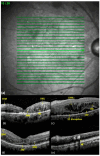Retinal Biomarkers in Diabetic Retinopathy: From Early Detection to Personalized Treatment
- PMID: 40004872
- PMCID: PMC11856754
- DOI: 10.3390/jcm14041343
Retinal Biomarkers in Diabetic Retinopathy: From Early Detection to Personalized Treatment
Abstract
Diabetic retinopathy (DR) is a leading cause of vision loss globally, with early detection and intervention critical to preventing severe outcomes. This narrative review examines the role of retinal biomarkers-molecular and imaging-in improving early diagnosis, tracking disease progression, and advancing personalized treatment for DR. Key biomarkers, such as inflammatory and metabolic markers, imaging findings from optical coherence tomography and fluorescence angiography and genetic markers, provide insights into disease mechanisms, help predict progression, and monitor responses to treatments, like anti-VEGF and corticosteroids. While challenges in standardization and clinical integration remain, these biomarkers hold promise for a precision medicine approach that could transform DR management through early, individualized care.
Keywords: biomarkers; diabetes; diabetes complications; diabetic retinopathy; ophthalmology; retinal biomarkers; retinal imaging.
Conflict of interest statement
The authors report no conflicts of interest in this work.
Figures

Similar articles
-
Advancing Diabetic Retinopathy Diagnosis: Leveraging Optical Coherence Tomography Imaging with Convolutional Neural Networks.Rom J Ophthalmol. 2023 Oct-Dec;67(4):398-402. doi: 10.22336/rjo.2023.63. Rom J Ophthalmol. 2023. PMID: 38239418 Free PMC article. Review.
-
Imaging and Biomarkers in Diabetic Macular Edema and Diabetic Retinopathy.Curr Diab Rep. 2019 Aug 31;19(10):95. doi: 10.1007/s11892-019-1226-2. Curr Diab Rep. 2019. PMID: 31473838 Review.
-
Advances in Structural and Functional Retinal Imaging and Biomarkers for Early Detection of Diabetic Retinopathy.Biomedicines. 2024 Jun 25;12(7):1405. doi: 10.3390/biomedicines12071405. Biomedicines. 2024. PMID: 39061979 Free PMC article. Review.
-
Studies of the retinal microcirculation using human donor eyes and high-resolution clinical imaging: Insights gained to guide future research in diabetic retinopathy.Prog Retin Eye Res. 2023 May;94:101134. doi: 10.1016/j.preteyeres.2022.101134. Epub 2022 Oct 29. Prog Retin Eye Res. 2023. PMID: 37154065 Review.
-
Advancing Diabetic Retinopathy Screening: A Systematic Review of Artificial Intelligence and Optical Coherence Tomography Angiography Innovations.Diagnostics (Basel). 2025 Mar 15;15(6):737. doi: 10.3390/diagnostics15060737. Diagnostics (Basel). 2025. PMID: 40150080 Free PMC article. Review.
Cited by
-
The Long-Standing Problem of Proliferative Retinopathies: Current Understanding and Critical Cues.Cells. 2025 Jul 18;14(14):1107. doi: 10.3390/cells14141107. Cells. 2025. PMID: 40710360 Free PMC article. Review.
References
Publication types
LinkOut - more resources
Full Text Sources

